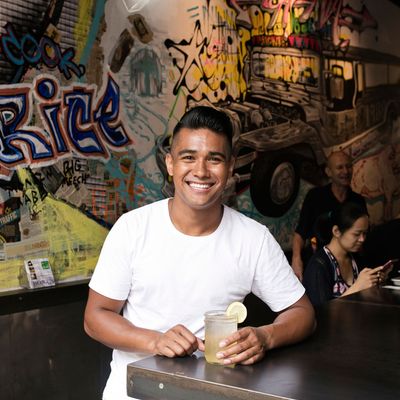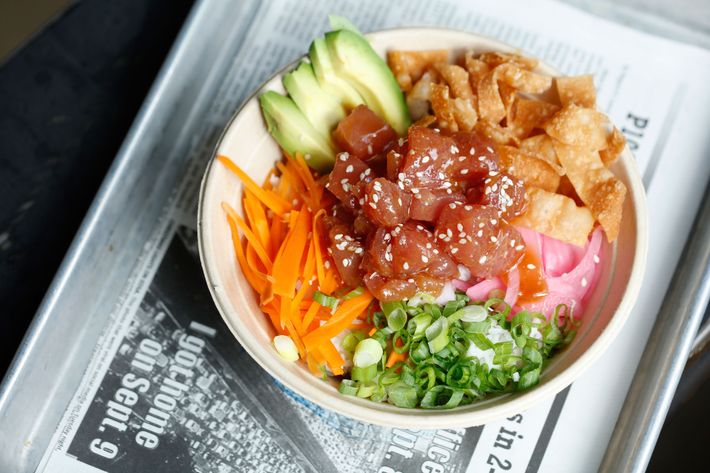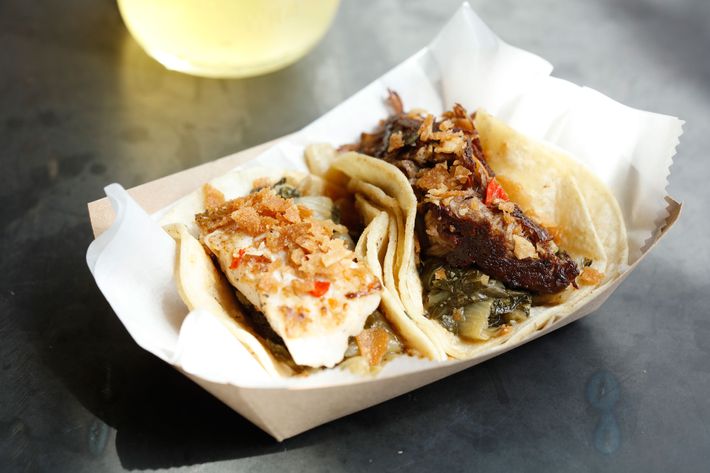
The new goal for budding restaurateurs isn’t necessarily earning critical acclaim through a three-star rave review; it’s going viral. In May, chef Jordan Andino opened a tiny restaurant in the West Village — a “Filipino taqueria” called 2nd City — with the idea of attracting young, tech-savvy clients. According to his business plan, if these millennials show up in full force, like they have for Black Tap’s wildly popular milkshakes, he has a concept that he can easily scale and open locations all around America.
At least so far, Andino’s plan seems to be working well. Day and night, teeny-tiny 2nd City is packed with customers, most of whom learn about the restaurant via Instagram or Yelp and come in to taste (and photograph) trendy dishes with tongue-in-cheek names, like “Nice Buns” (pork-belly bao buns) and “Plan B-Rito” (a breakfast burrito). Grub sat down with Andino to learn about his new-age business strategy.
How’d you get your start in the industry?
I grew up in Toronto and moved to L.A. when I was 9. Every summer and winter, I would come back to Toronto and cook with my dad. He was a chef in Toronto. Instead of summer camp or hanging out or whatever, I would literally be working for three months, twice a year — from ages 9 to 17. My training got polished off when I staged at the French Laundry and Spago.
Prior to 2nd City, I was the executive chef at Harlow, which is located in Sag Harbor and in midtown. I met my two partners there. Prior to that, I was a corporate chef, and before that I was an in-house for a company called HEI.
What inspired the concept of a Filipino taqueria?
Honestly, a Filipino taqueria, it literally doesn’t exist in the world. I’m the only one to coin that term. To be the first to market anything is always good. What I’m doing is bringing Filipino food to the American masses. I want to introduce it in an accessible, tangible way, without being overtly Filipino. It’s stuff that everyone’s had before: tacos, burritos, poke bowls. All the rage. With just a hint of Filipino-ness sprinkled on top.
I live in the neighborhood, and every time I walk by your tiny restaurant is slammed. When did it start to pick up steam?
What do you call it in finance? Hockey stick? It opened in May, and soon after the momentum gained as more and more Instagram people came in, and it’s just been growing.
It seems like social media is a big part of your strategy.
I would definitely say Yelp and Instagram make up — this is not a joke — 70 percent of my business … Personally, from an artistic chef side, I don’t like it, but I completely get it. I see that the marketing and PR of restaurants is evolving.
How have you cultivated that attention? I see you have cheeky names for your dishes, like “Bi-Curious Tacos.” Was it part of your business strategy to make your restaurant go viral?
I just wanted to have funny names because I think funny names are fun. I wanted to have good-looking food because people eat with their eyes. I wanted a cool place to hang out. You were listening to Mariah Carey while you were waiting for me. I wanted my place to be really lax and cool and break the mold.
Do “influencers” come in asking for free food?
I’m trying to run a business, so, in general, free food is not something I like to give away, even to family. But in the beginning, it happened a lot, to get that momentum going. I understood that. I took the loss and the hit on that. I knew that would eventually and somehow turn into sales.

You’re featuring types of dishes that are quite trendy and photogenic, like poke bowls and pork buns, so that certainly helps.
Agreed, agreed. Places like Momofuku helped pave the way for me. It’s like how Corey Lee in San Francisco is taking the best dish from every fine-dining restaurant and putting it into his own restaurant. That’s kind of what I’m doing, but through a vessel of what’s most popular.
And as I understand, you’re building this to scale. You want to open locations all over the city? Or the country?
This is not meant to be one restaurant. This is meant to be 20 restaurants in eight to ten years, full scale. Eventually, I want to franchise. Every single thing we’re doing is optimized so that 20 of these restaurants can open. And so people can roll it out easily — it’s by the book, and you can calculate it. If I want to expand and become a businessman, you have to have these small little things in place now.
Here’s a quick example: We don’t take cash. When you don’t take cash, you don’t have to worry about robberies. You don’t have to worry about training a manager to handle banks. And someone wants to invest and says, “Let me see your books,” we’ve recorded everything. It’s just that much easier for people to understand finances.
How else are you structuring this to scale?
This menu is simple, easy, and appealing to a collegiate-level type of market. The name 2nd City is a nod that we’re going to open in secondary markets. And also because my mom is from the second-largest city in the Philippines. But instead of Denver, Boulder. Instead of Houston, Austin. Instead of New York—
You did start in the West Village. I wouldn’t call that a secondary market.
Well, we want to be able to create food that people in these secondary markets understand. Everyone knows what a taco is no matter what market you’re in. Burritos, too. Thank you, Chipotle. Familiarity breeds business. Also, we want to create a vibe that isn’t pretentious. You can come in dressed however you want, with any amount of income, and you feel comfortable in there. That’s the point.
We were looking around New York and saying, “Which neighborhood needs a place like this?” Does the West Village need it? Immediately, you know because the West Village has a lot of restaurants, but they all have check averages around $60 to $80 and often three-hour waits. Where else in this area can you get something under $10 in ten minutes? Literally nowhere.
It’s interesting that you didn’t make this a takeout restaurant, which would’ve been more efficient. You can actually sit down at the bar.
Starbucks did it 15 years ago — created a sense of a third place. This is the new third place. If you look on the walls, I have nothing but USB ports everywhere. I don’t have plugs. I have free 5G Wi-Fi. Everything is Instagrammable. I have hashtags on my mirrors. Pokémon Go is trending, and I have something on my board outside about it. The whole point is that this is built for the millennials — the youth.
The fish in your poke bowl tastes pretty high-quality. How are you balancing your food costs with keeping your prices low?
Ideally, a fast-casual restaurant should have a food cost below 20 percent. Mine is above that, but it’s also significantly below 30. I would rather serve quality food and make money over a longer period of time. By having consistent quality, I will be able to sustain myself for the lifetime of my lease.
What’s your most popular item?
Saturday and Sunday, it’s the “Plan B-Rito.” It is hands down the best breakfast burrito in New York.
Has the name offended any customers?
People have been offended, yeah. But, honestly, I don’t care. This is part of the business. If you don’t like it, then don’t eat here. It’s pretty much that simple. Then the “Poke Me,” that’s our Monday-to-Friday best seller.

What’s up with all of your “secret” menu items?
I have eight of them. It’s because I’m from L.A., and I grew up on In-N-Out, which I think has 58 secret menu items. I love the sense of community it creates. The more you come, the more you can access, because it’s all password-based.
Where do you think you’ll open next?
We’ll be opening in Bushwick next, at Troutman and Knickerbocker, as long as all the paperwork goes through.
You’re certainly branding the restaurant in a strategic way, but you’re also branding yourself. You call yourself a “celebrity chef” on your website. Why?
I used to be a model. I think that helps with the TV stuff. Do you have the talent? Are you personable? It kind of just came to me. It was never truly me rushing it, or being like, “I want to be a celebrity chef.” I did all these things and had fun. I’ve been on 18 television shows, which is crazy to me. So now I’m like, “Shit, I might be a celebrity chef.” But I’m following my passion, and if that leads me to be a celebrity chef, then let’s own it. Let’s accept it.
How do you think it impacts your business?
Every place needs a name or a face or something to attach itself to — like Danny Meyer. Everyone knows what he looks like. Everyone knows his name.




